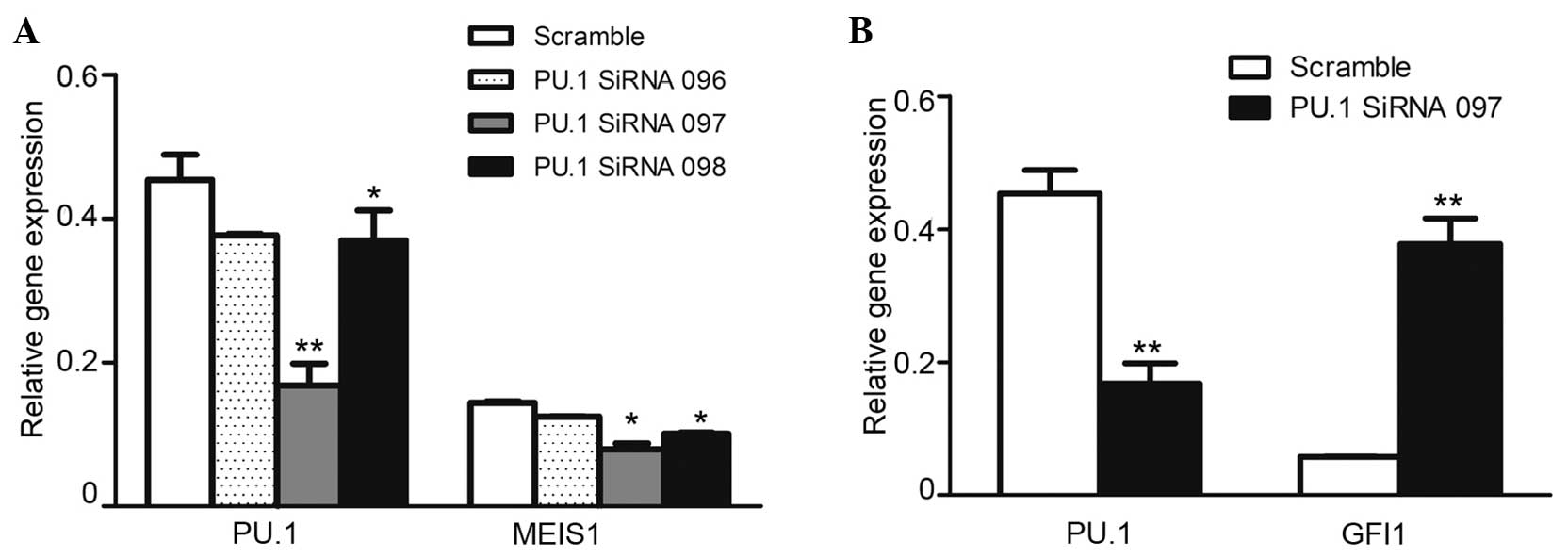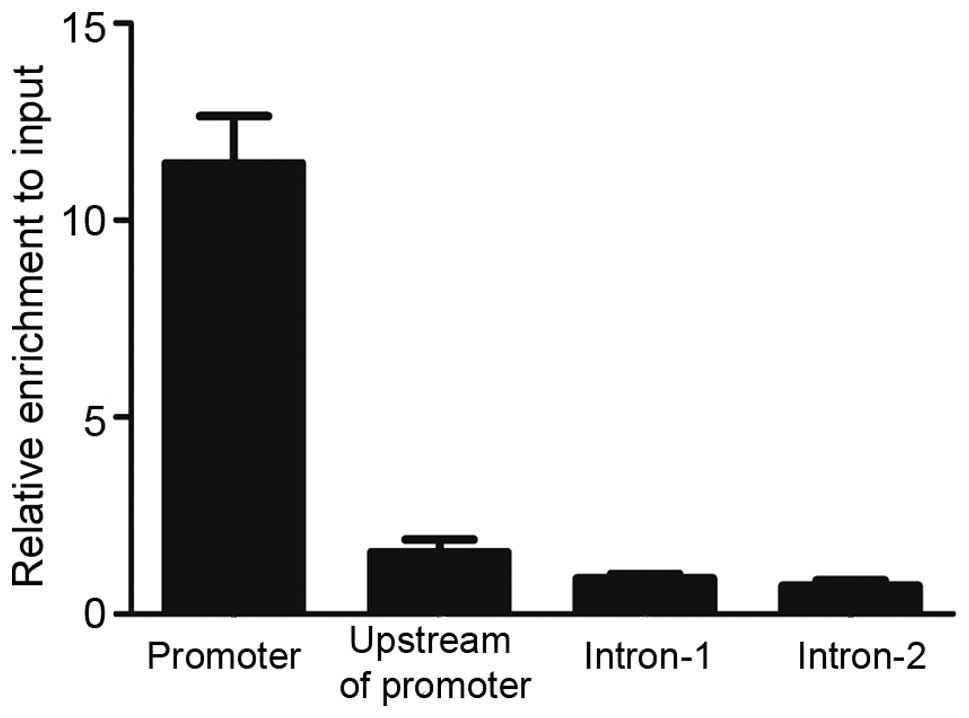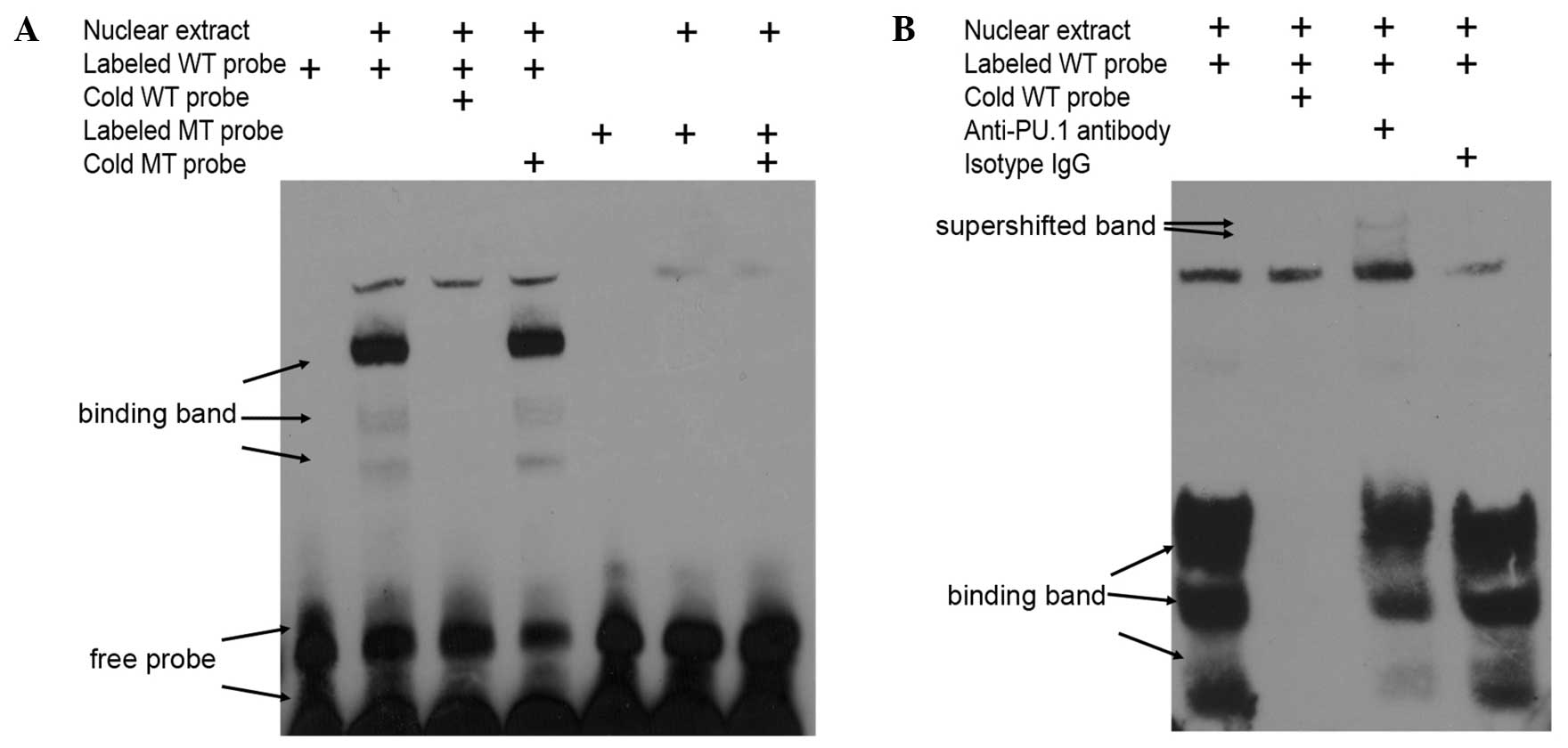|
1
|
Orkin SH and Zon LI: Hematopoiesis: An
evolving paradigm for stem cell biology. Cell. 132:631–644. 2008.
View Article : Google Scholar : PubMed/NCBI
|
|
2
|
Kehrl JH: Hematopoietic lineage
commitment: role of transcription factors. Stem Cells. 13:223–241.
1995. View Article : Google Scholar : PubMed/NCBI
|
|
3
|
Gangenahalli GU, Gupta P, Saluja D, Verma
YK, Kishore V, Chandra R, Sharma RK and Ravindranath T: Stem cell
fate specification: Role of master regulatory switch transcription
factor PU.1 in differential hematopoiesis. Stem Cells Dev.
14:140–152. 2005. View Article : Google Scholar : PubMed/NCBI
|
|
4
|
Aikawa Y, Katsumoto T, Zhang P, Shima H,
Shino M, Terui K, Ito E, Ohno H, Stanley ER, Singh H, et al:
PU.1-mediated upregulation of CSF1R is crucial for leukemia stem
cell potential induced by MOZ-TIF2. Nat Med. 16:580–585, 1p
following 585. 2010. View
Article : Google Scholar : PubMed/NCBI
|
|
5
|
Houston IB, Huang KJ, Jennings SR and
DeKoter RP: PU.1 immortalizes hematopoietic progenitors in a
GM-CSF-dependent manner. Exp Hematol. 35:374–384. 2007. View Article : Google Scholar : PubMed/NCBI
|
|
6
|
Mak KS, Funnell AP, Pearson RC and
Crossley M: PU.1 and Haematopoietic Cell Fate: Dosage Matters. Int
J Cell Biol. 2011:8085242011. View Article : Google Scholar : PubMed/NCBI
|
|
7
|
Friedman AD: Transcriptional control of
granulocyte and monocyte development. Oncogene. 26:6816–6828. 2007.
View Article : Google Scholar : PubMed/NCBI
|
|
8
|
Iwasaki H, Somoza C, Shigematsu H, Duprez
EA, Iwasaki-Arai J, Mizuno S, Arinobu Y, Geary K, Zhang P, Dayaram
T, et al: Distinctive and indispensable roles of PU.1 in
maintenance of hematopoietic stem cells and their differentiation.
Blood. 106:1590–1600. 2005. View Article : Google Scholar : PubMed/NCBI
|
|
9
|
Nutt SL, Metcalf D, D'Amico A, Polli M and
Wu L: Dynamic regulation of PU.1 expression in multipotent
hematopoietic progenitors. J Exp Med. 201:221–231. 2005. View Article : Google Scholar : PubMed/NCBI
|
|
10
|
Renneville A, Roumier C, Biggio V, et al:
Cooperating gene mutations in acute myeloid leukemia: A review of
the literature. Leukemia. 22:915–931. 2008. View Article : Google Scholar : PubMed/NCBI
|
|
11
|
Seshire A, Rößiger T, Frech M, et al:
Direct interaction of PU.1 with oncogenic transcription factors
reduces its serine phosphorylation and promoter binding. Leukemia.
26:1338–1347. 2012. View Article : Google Scholar : PubMed/NCBI
|
|
12
|
Mueller BU, Pabst T, Fos J, et al: ATRA
resolves the differentiation block in t (15;17) acute myeloid
leukemia by restoring PU.1 expression. Blood. 107:3330–3338. 2006.
View Article : Google Scholar : PubMed/NCBI
|
|
13
|
Vangala RK, Heiss-Neumann MS, Rangatia JS,
et al: The myeloid master regulator transcription factor PU.1 is
inactivated by AML1-ETO in t (8;21) myeloid leukemia. Blood.
101:270–277. 2003. View Article : Google Scholar : PubMed/NCBI
|
|
14
|
Wang K, Wang P, Shi J, et al: PML/RARalpha
targets promoter regions containing PU.1 consensus and RARE half
sites in acute promyelocytic leukemia. Cancer Cell. 17:186–197.
2010. View Article : Google Scholar : PubMed/NCBI
|
|
15
|
Staber PB, Zhang P, Ye M, et al: Sustained
PU.1 levels balance cell-cycle regulators to prevent exhaustion of
adult hematopoietic stem cells. Mol Cell. 49:934–946. 2013.
View Article : Google Scholar : PubMed/NCBI
|
|
16
|
Zhou J, Wu J, Li B, et al: PU.1 is
essential for MLL leukemia partially via crosstalk with the
MEIS/HOX pathway. Leukemia. 28:1436–1448. 2014. View Article : Google Scholar : PubMed/NCBI
|
|
17
|
Kumar AR, Li Q, Hudson WA, Chen W, Sam T,
Yao Q, Lund EA, Wu B, Kowal BJ and Kersey JH: A role for MEIS1 in
MLL-fusion gene leukemia. Blood. 113:1756–1758. 2009. View Article : Google Scholar : PubMed/NCBI
|
|
18
|
Dahl R, Iyer SR, Owens KS, Cuylear DD and
Simon MC: The transcriptional repressor GFI-1 antagonizes PU.1
activity through protein-protein interaction. J Biol Chem.
282:6473–6483. 2007. View Article : Google Scholar : PubMed/NCBI
|
|
19
|
Zeisig BB, Milne T, García-Cuéllar MP,
Schreiner S, Martin ME, Fuchs U, Borkhardt A, Chanda SK, Walker J,
Soden R, et al: Hoxa9 and Meis1 are key targets for
MLL-ENL-mediated cellular immortalization. Mol Cell Biol.
24:617–628. 2004. View Article : Google Scholar : PubMed/NCBI
|
|
20
|
Hu YL, Fong S, Ferrell C, Largman C and
Shen WF: HOXA9 modulates its oncogenic partner Meis1 to influence
normal hematopoiesis. Mol Cell Biol. 29:5181–5192. 2009. View Article : Google Scholar : PubMed/NCBI
|
|
21
|
Xiang P, Lo C, Argiropoulos B, et al:
Identification of E74-like factor 1 (ELF1) as a transcriptional
regulator of the Hox cofactor MEIS1. Exp Hematol. 38:798, 808
e1-e2. 2010. View Article : Google Scholar : PubMed/NCBI
|
|
22
|
Orlovsky K, Kalinkovich A, Rozovskaia T,
et al: Down-regulation of homeobox genes MEIS1 and HOXA in
MLL-rearranged acute leukemia impairs engraftment and reduces
proliferation. Proc Natl Acad Sci USA. 108:7956–7961. 2011.
View Article : Google Scholar : PubMed/NCBI
|
|
23
|
Wong P, Iwasaki M, Somervaille TC, So CW
and Cleary ML: Meis1 is an essential and rate-limiting regulator of
MLL leukemia stem cell potential. Genes Dev. 21:2762–2774. 2007.
View Article : Google Scholar : PubMed/NCBI
|
|
24
|
Gupta P, Gurudutta GU, Saluja D and
Tripathi RP: PU.1 and partners: Regulation of haematopoietic stem
cell fate in normal and malignant haematopoiesis. J Cell Mol Med.
13:4349–4363. 2009. View Article : Google Scholar : PubMed/NCBI
|
|
25
|
Dakic A, Metcalf D, Di Rago L, Mifsud S,
Wu L and Nutt SL: PU.1 regulates the commitment of adult
hematopoietic progenitors and restricts granulopoiesis. J Exp Med.
201:1487–1502. 2005. View Article : Google Scholar : PubMed/NCBI
|
|
26
|
Rosenbauer F, Wagner K, Kutok JL, et al:
Acute myeloid leukemia induced by graded reduction of a
lineage-specific transcription factor, PU.1. Nat Genet. 36:624–630.
2004. View
Article : Google Scholar : PubMed/NCBI
|
|
27
|
Suraweera N, Meijne E, Moody J,
Carvajal-Carmona LG, Yoshida K, Pollard P, Fitzgibbon J, Riches A,
van Laar T, Huiskamp R, et al: Mutations of the PU.1 Ets domain are
specifically associated with murine radiation-induced, but not
human therapy-related, acute myeloid leukaemia. Oncogene.
24:3678–3683. 2005. View Article : Google Scholar : PubMed/NCBI
|
|
28
|
Walter MJ, Park JS, Ries RE, Lau SK,
McLellan M, Jaeger S, Wilson RK, Mardis ER and Ley TJ: Reduced PU.1
expression causes myeloid progenitor expansion and increased
leukemia penetrance in mice expressing PML-RARalpha. Proc Natl Acad
Sci USA. 102:12513–12518. 2005. View Article : Google Scholar : PubMed/NCBI
|














